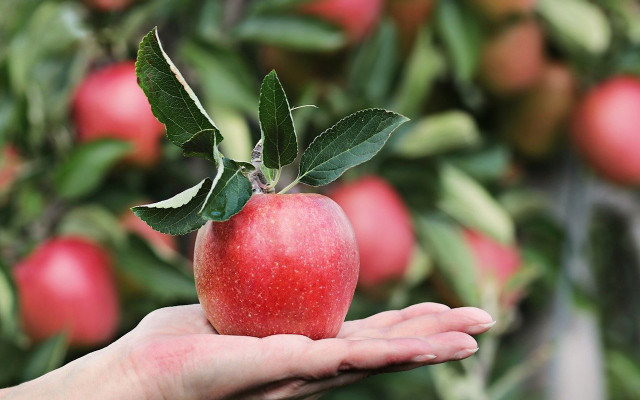Making homemade apple cider vinegar is easy, but takes a bit of patience. We’ll show you two methods of making apple cider vinegar, and give you some tips for how to use it when it’s done.
Homemade apple cider vinegar can be made in a few different ways. We’ll share two different methods, one beginning with raw apples, and the other with white vinegar.
Homemade Apple Cider Vinegar from Apples

For this variant of homemade apple cider vinegar, it’s best to use apples that have just been picked. If you aren’t lucky enough to have your own apple tree, try searching for a local farmer’s market. If you end up buying them from the supermarket, it’s best to choose organic to make sure that no pesticides end up in your vinegar.
For about two liters of apple cider vinegar, you’ll need these ingredients:
- 2 pounds of apples
- 1/2 cup sugar
- cold water
You’ll also need a large bowl, a cheesecloth or clean kitchen towel, and screw-top jars.
How to make apple cider vinegar from apples:
This recipe takes some patience, but isn’t difficult. In total, it will take about 14-18 weeks for your homemade apple cider vinegar to be ready to use.
- Wash, core, and chop the apples.
- Fill the apple pieces into a large bowl and cover with water about 1½ inches.
- Add the sugar and stir well.
- If the apple pieces begin to float, place a small plate on top, to keep them underwater.
- Lay a kitchen towel over the bowl and place it in the refrigerator or cellar. Let stand for one week, stirring once per day.
- As soon as white foam begins to form on top of the liquid, filter the apple water through a cheesecloth or clean kitchen towel into a new bowl.
- Sterilize your screw-top jars to get rid of any possible unwanted microbes.
- Fill the filtered apple water into the clean screw-top jars and cover with kitchen paper.
- Place the jars in a warm place (about 75°F) and let stand for five to seven weeks. Don’t be alarmed: after about half the time, the “mother of vinegar” will begin to form. This will look like a slimy disc floating on top of the liquid. It means that the fermentation is working as planned.
- When the seven weeks are up, fill the vinegar into smaller, sterilized bottles and close them. Leave for another eight to ten weeks in a cool place to mature.
Making Apple Cider Vinegar from White Vinegar



If you’re not exactly interested in waiting three to four months for your homemade apple cider vinegar to be finished, you can gain a head start by using regular white vinegar as a base. Instead of three months, this recipe requires three weeks of waiting time.
Ingredients:
- 3 large apples
- 1 liter white vinegar
- one large glass bottle or jar that can hold at least 1.5 liters
Method:
- Wash and core the apples.
- Chop the apples into small pieces and fill them into the glass bottle.
- Pour the vinegar over the apple pieces and close the bottle.
- Place the bottle in the refrigerator or cellar for three weeks.
Why is making your own vinegar better than buying it?
- It helps reduce food waste: If you or someone you know has an apple tree, you’ll already know that it often takes a group effort to process all the fruit. Making homemade apple cider vinegar is the perfect way to use up the apples before they go bad.
- You are what you eat: By making your own homemade apple cider vinegar, you can be sure that it contains no suspicious chemicals or other additives.
- It produces less garbage: Reuse glass jars to store your vinegar. This way, you won’t produce any additional plastic or glass waste.
Another way to use leftover apples: Vegan Apple Pie Recipe: A Seasonal Favorite
Ways to Use Homemade Apple Cider Vinegar



Try using your homemade apple cider as an ingredient in recipes like these:
- Fire Cider: Recipe and Benefits of the Health Tonic
- How to Make Tempeh: Easy Homemade Tempeh Recipe
- Easy Spelt Bread Recipe: Simple and Quick 1 Hour Prep
- Lentil-Walnut Vegan Roast: Mouth-Watering Meat-Free Main Dish
- Oxymel: A Sour Elixir to Boost Your Immune System
Apple cider vinegar can also be used for hair care and as a natural remedy for sore throats.
This article has been translated from German to English by Christie Sacco. You can read the original version here: Apfelessig selber machen: Mit diesem Rezept und etwas Geduld gelingt er dir
** Links to retailers marked with ** or underlined orange are partially partner links: If you buy here, you actively support Utopia.org, because we will receive a small part of the sales proceeds. More info.Do you like this post?






